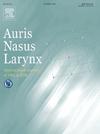Use of cartilage-conduction hearing aids in a child with Crouzon syndrome and meatal atresia
IF 1.5
4区 医学
Q2 OTORHINOLARYNGOLOGY
引用次数: 0
Abstract
A cartilage-conduction hearing aid (CCHA) transmits sound vibrations to the inner ear via the ear cartilage rather than through air or bone. They can be used in patients with meatal atresia and persistent otorrhea. Unlike bone-conduction hearing aid (BCHA), there is no need for pressure between the transducer and the temporal bone. Effective hearing is achieved by simply bringing the cartilage-conduction transducer into contact with the auricular cartilage. Crouzon syndrome is characterized by craniosynostosis and is associated with a high incidence of meatal atresia, which causes conductive hearing loss. Cranial enlargement surgeries are performed repeatedly during infancy and early childhood to reduce the symptoms of intracranial hypertension. Therefore, BCHA can be difficult to use. We report the case of a child with Crouzon syndrome who required multiple cranial surgeries for craniosynostosis, in whom CCHAs were applied. As a result, his vocabulary development progressed, and after 22 months of using the CCHA, he reached the expected developmental level for his age.
软骨传导助听器在Crouzon综合征合并闭锁儿童中的应用
软骨传导助听器(CCHA)通过耳软骨而不是通过空气或骨头将声音振动传递到内耳。可用于有闭锁和持续性耳漏的患者。与骨传导助听器(BCHA)不同,换能器和颞骨之间不需要压力。只需将软骨传导换能器与耳廓软骨接触即可获得有效的听力。Crouzon综合征以颅缝闭合为特征,并伴有高发生率的金属闭锁,导致传导性听力损失。在婴儿期和幼儿期反复进行颅骨扩大手术以减轻颅内高压的症状。因此,BCHA可能很难使用。我们报告了一例患有Crouzon综合征的儿童,他需要多次颅脑手术治疗颅缝闭锁,其中应用了CCHAs。结果,他的词汇发展得到了进步,在使用CCHA的22个月后,他达到了他的年龄预期的发展水平。
本文章由计算机程序翻译,如有差异,请以英文原文为准。
求助全文
约1分钟内获得全文
求助全文
来源期刊

Auris Nasus Larynx
医学-耳鼻喉科学
CiteScore
3.40
自引率
5.90%
发文量
169
审稿时长
30 days
期刊介绍:
The international journal Auris Nasus Larynx provides the opportunity for rapid, carefully reviewed publications concerning the fundamental and clinical aspects of otorhinolaryngology and related fields. This includes otology, neurotology, bronchoesophagology, laryngology, rhinology, allergology, head and neck medicine and oncologic surgery, maxillofacial and plastic surgery, audiology, speech science.
Original papers, short communications and original case reports can be submitted. Reviews on recent developments are invited regularly and Letters to the Editor commenting on papers or any aspect of Auris Nasus Larynx are welcomed.
Founded in 1973 and previously published by the Society for Promotion of International Otorhinolaryngology, the journal is now the official English-language journal of the Oto-Rhino-Laryngological Society of Japan, Inc. The aim of its new international Editorial Board is to make Auris Nasus Larynx an international forum for high quality research and clinical sciences.
 求助内容:
求助内容: 应助结果提醒方式:
应助结果提醒方式:


